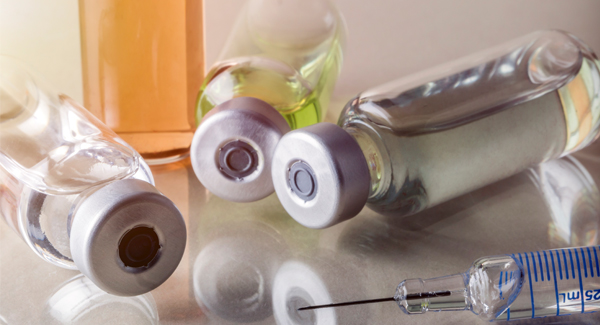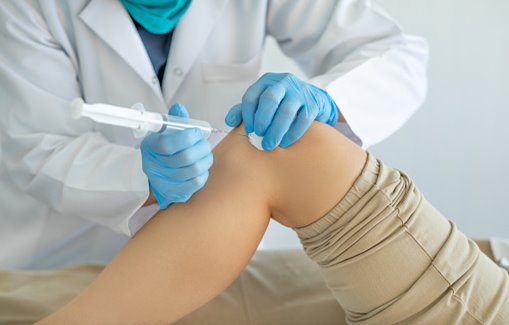Easing the Pain of Injections for Juvenile Arthritis
Learn tips to help make shot time easier for you and your child.
By Jennifer Davis
Kids hate shots, but when it comes to managing juvenile arthritis (JA), sometimes they are necessary. Biologic injections can sting more than others, making shot time even more dreaded. While drug makers are taking steps to help lessen the pain of these medications, there are many things you can do to take the sting out of shot day.
Why Injections Hurt
Thicker medications and ones made with certain preservatives can make shots sting even more, says Cara M. Hoffart, DO, a pediatric rheumatologist at Children’s Mercy in Kansas City, MO. “Getting an injection is hard enough. But if you have a medication that causes burning at the injection site or as it’s going in, that can make injections traumatic for patients,” she says.
Hoffart knows what that pain is like because she gets biologic injections to manage her own ankylosing spondylitis. She admits that painful shots have made her think about trying other medications.
“Not only is it a bad experience for the patient and their family, but [pain] can also really affect compliance,” she says. “And if you aren’t treating the disease, there will be long-term effects.” If shot time is a constant struggle, there may be other modes of administration for some types of medicine. Talk to your child's doctor about what those are and if they are an option.
What Drug Makers Are Doing
Several drug makers are taking steps aimed at reducing the pain of injections.
A new version of adalimumab (Humira) no longer contains citrate buffers and other inactive ingredients associated with pain. The new version also uses a thinner needle and injects 50 percent less liquid (while still delivering the same concentration of medication), both of which may be linked to less pain.
“Among the patients I have changed to the citrate-free version, the feedback is very positive. I have some patients who say they don’t feel the medication at all,” Hoffart says.
Etanercept (Enbrel Mini) also has a new phosphate-free drug formulation that Amgen says shows a significant reduction in injection site pain. The device also has an injection speed switch so people can see which speed is most comfortable for them.
The makers of tocilizumab (Actemra) say their product doesn’t include sodium citrate, which they say may cause pain in some patients.
What You Can Do
There are many things you can do to help reduce pain during injections for your child.
- Apply ice or gel packs before and after. Just don’t apply directly on the skin, which can cause a frostbite-like burn.
- Let the injectable medicine get to room temperature for about 30 minutes before using. This can reduce the sting. FYI — it’s not safe to warm it up any other way (no microwaving!)
- Make sure the alcohol you use to clean the injection site dries completely. Piercing skin through wet alcohol can really burn.
- Use an over-the-counter numbing cream that’s 2.5% lidocaine and 2.5% prilocaine. Apply a thick layer to the area about an hour before the injection. Seal the cream with plastic food wrap to keep the area airtight and then wipe it off before the shot.
- Allow your child to select when and where the shot is given and where it goes. This gives your child a sense of control over the situation, which can reduce anxiety.
- Choose a distraction activity, like blowing bubbles or watching TV. Victoria Ruffing, a registered nurse and director of patient education at the Johns Hopkins Arthritis Center, says she finds it helpful to have children take a deep breath and give them the injection on the exhale. “They are thinking about exhaling and not tensing up,” she explains.
- Use an auto-injector pen to hide the sharp point of the needle.
- Make sure you’re using the correct technique and inserting the injection where it’s meant to go — between the skin and muscle rather than directly into muscle.
- Ask the doctor about new places to administer the injection. Some people find less discomfort in the stomach but make sure it’s a safe place free of big veins.
If you’re nervous, it’s likely your child will be too. Ask your child’s doctor about training for parents, including videos and opportunities to practice. Until you get the hang out it, you can rely on a nearby medical clinic to give your child the shot for a fee or ask a family member or friend for help.
If your child’s fear is extreme, you may need to take additional steps to get her used to the idea and go through the process slowly. Ask your child to sit with the syringe, then later ask her to hold it. Eventually, add the needle. As your child becomes used to the equipment, hopefully, her needle fears will lessen too.
Devices that use a combination of cold and vibration may lessen pain and offer children some relief. A small reward for bravery, like a sticker or allowing extra screen-time, can work wonders for young kids, too. “You want the child to buy into what is being done and if a reward works, then it works,” Ruffing says.

Stay in the Know. Live in the Yes.
Get involved with the arthritis community. Tell us a little about yourself and, based on your interests, you’ll receive emails packed with the latest information and resources to live your best life and connect with others.


